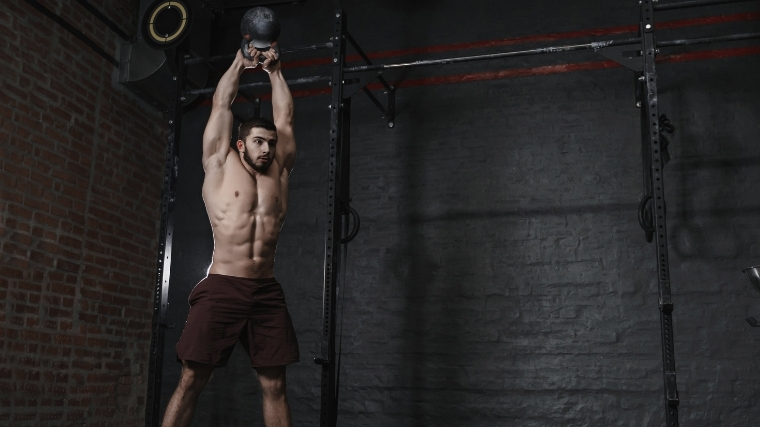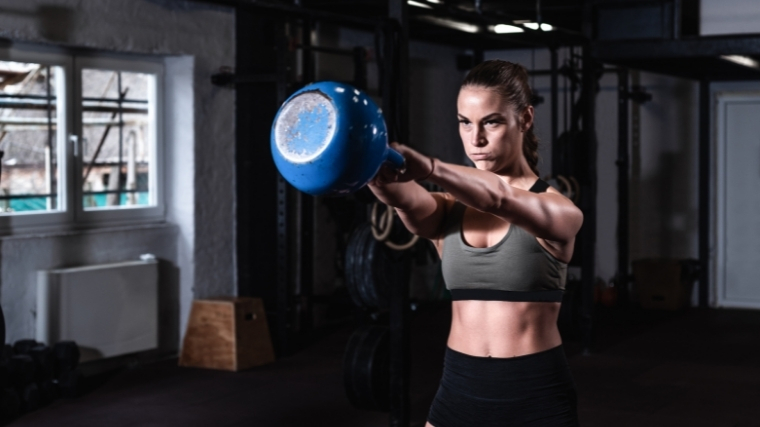The kettlebell swing is a ballistic movement seen throughout strength and conditioning realms, functional fitness competitions, and everyday fitness. Two popular variations are the Russian and American kettlebell swing.
The most common form of kettlebell swings is the Russian version — a power-focused swing variation that minimizes arm involvement and prioritizes hip drive to move the kettlebell to chest height. On the other hand, the American version has the lifter swing the kettlebell all the way overhead. If you’re trying to figure out which type of kettlebell exercise matches your goals, you’ll want to learn all about kettlebell swing form, function, and performance differences.
Russian and American Kettlebell Swings Form
The version of the two-handed kettlebell swing you’re probably most used to seeing in the gym is the Russian swing. Despite the two movements looking pretty different, they share a lot of similarities and are functionally very similar. Here’s how to do both.
How to Do the Russian Kettlebell Swing
It’s very tempting to pick up a bell and start swinging. That said, learning to perform a perfect kettlebell swing is worth it if you want to build maximum strength, increase power, and avoid injuries.
- Set up with your feet slightly wider than hip-width apart, about a foot or two behind the bell. Slightly bend your knees forward and bend forward to grab the handle (or horn) with both hands.
- Pull your shoulder blades down and back, keep your spine neutral, and hike the weight back behind you. Try to keep the bottom of the bell above your knees throughout this part of the movement.
- Engage your glutes to quickly drive your hips forward, straightening the knees until you’re in an upright position. Keep your elbows soft.
- Keep your body in a vertical line (don’t hyperextend the back) as the kettlebell floats up around chest level.
- Stabilize and guide the weight back down its path back behind you. Again, aim to keep the bell just below your groin instead of getting close to the ground (to avoid over-utilizing and possibly arching your thoracic spine).
How to Do the American Kettlebell Swing
If you have excellent shoulder mobility and overhead stability and only have access to a light kettlebell, the American kettlebell swing might be a variation worth trying. Make sure your upper body is sufficiently warmed up, set your stance, and get ready to make the weight travel high.
- Set up in the same way as you do for the Russian kettlebell swing and perform the swing in the same manner.
- Instead of stabilizing the weight at chest height, use the momentum from your hip drive to swing the weight overhead. Do not pull with your shoulders. Simply produce enough force so that the lighter weight glides over head.
- Allow the weight to fall back down, using just enough control so it doesn’t smash into the floor.
A Note About American Swings
It’s a good idea to learn the Russian kettlebell swing before attempting American swings. Without sound swinging mechanics, both exercises may lead to an injury.
Secondly, lifters need to have enough shoulder mobility and scapular stabilization to be in the overhead swing position. Unlike many overhead positions, the American swing requires a lifter to take an extremely narrow grip width in the overhead position, increasing stress and the mobility needs of an athlete.
American swings can sometimes lead to compensation patterns when a lifter lacks overhead mobility and stability are present. This means the lifter may rely on other muscles — muscles that aren’t meant to be engaged — to pick up the slack during American swings. These compensations may results in excessive lumbar flexion, cervical flexion while forcing the head forward “under the kettlebell,” and instability in the shoulder complex.
American swings are also usually performed to induce fatigue or endurance since power outputs tend to be lower than Russian variations, which increases the risk of dropping or releasing kettlebells on oneself or others.
Similarities and Differences Between the Russian and American Kettlebell Swing
Both the American and the Russian kettlebell swings are performed in almost the same way. Fundamentally, they are both explosive hip hinge movements. You start the lift with the same setup, and the bottom of the swing should look identical.
The difference in these kettlebell swing variations lies in the end position. Whereas the Russian version stops around chest height, the American version goes all the way overhead. The former engage your lats to stabilize and reverse the swing. The latter depends on your shoulder mobility to finish the swing overhead and your shoulder stability to reverse the swing back down.
Russian Vs. American Kettlebell Swing — Performance Differences
Though the lifts are more similar in form than not, Russian and American kettlebell swings offer different performance benefits. The ability to lift heavier loads with Russian swings means greater strength gains. Conversely, the increased range of motion of American kettlebell swings can mean more practice developing overhead mobility and stability.
General Strength
Since you can load Russian kettlebell swings much heavier than American swings, they’re better for building strength. The increased weight translates into a more direct carry-over into all your main lifts. Because Russian swings recruit your lats for braking and stabilizing the weight at chest level, they’ll get a lot stronger. Your grip strength will also improve more since you’re able to load more weight.
Conditioning
Unlike the Russian swing, the American swing requires a lifter to end with the weight in the overhead position rather than stopping at chest/head level. The added overhead component requires a great deal of shoulder mobility and scapular stabilization. Because American swings require a longer range of motion, one could argue that they’re more taxing overall and are better for conditioning.

The American kettlebell swing is often utilized in endurance and metabolic conditioning workouts, as it’s thought to induce greater work capacity than the Russian swing. Although the added overhead component potentially increased work capacity, since distance travel affects that, lighter loading abilities of this swing may diminish the significance of the overhead overall effect on a lifter than a lifter performing heavier Russian swings. Russian swings can also be used as a viable conditioning tool while minimizing potential injury in those with poor braking abilities, core control, and overhead mobility.
Power
The Russian swing has a greater application to power sports due to increased loading and velocities via hip extension. Due to the overhead component of the American swing, speeds and loads often fall to allow athletes to perform them safely. So if you’re looking to increase your capacity to generate a lot of power, Russian kettlebell swings should be your go-to.
Which Exercise is Better For Strengthening Your Main Lifts?
For powerlifters, functional fitness athletes, and folks generally trying to get strong, your main lifts are likely the big three (four if you include the overhead press). In that case, the Russian kettlebell swing will carry over best to your main lifts. Why? The lower-end position enables you to swing a much heavier weight. That will translate into more strength for your glutes and hamstrings. You’ll also improve your grip strength more with heavier weights, which you need for your big lifts. Not to mention, Russian swings strengthen your lats — which are definitely important movers in your biggest lifts.
If your main lifts are Olympic lifts, you probably already have solid shoulder mobility and stability. In that case, you might benefit from American kettlebell swings. They’ll give you more practice with overhead movements. But because you’ll perform them with light bells, they won’t tax your central nervous system as severely as heavy lifts.
Who Should Use Russian Kettlebell Swings
If you’re new to kettlebell training, you definitely want to stick with Russian swings for quite some time. They might seem simple, but they can take a while to master. And you want to go through that learning process with the Russian swing before the more technically difficult American swing.
That doesn’t mean the Russian kettlebell swing is less advanced, though. On the contrary, Strength athletes of all levels benefit from the Russian kettlebell swing. This swing will improve your grip strength, overall body strength, lat strength, hip hinge mechanics and power, and give you excellent hinging practice. If any of those things are part of your goals, you want to incorporate Russian kettlebell swings into your training.
Who Should Use American Kettlebell Swings
If you’re an Olympic lifter who performs heavy snatches or a CrossFitter who does high volume snatches, you should already have excellent shoulder mobility and stability. If that’s the case, you might want to sprinkle light American kettlebell swings into your training arsenal. Keep it light to avoid injury, but adding them can serve to polish off your warmup. They can also give you that extra conditioning boost you’re looking for.
How to Program Each
When you’re near the end of your warm-up, either type of kettlebell swing can be used to really polish off your movement prep. Once you’ve lubricated your joints and gotten your muscles ready to go, swings can help you transition into a harder workout. Just choose a relatively light weight, so you’re not overdoing it.

You can also make kettlebell swings the crux of your training. You’re more likely to want to do this with the Russian kettlebell swing. This specific variation allows you to move more weight, and it’s less likely to injure you or exacerbate already-existing shoulder pain. You can program kettlebell-only training sessions. Or, you can superset them into your lifting days for an extra metabolic kick. Kettlebell swings are also excellent active recovery tools. As long as you have excellent shoulder mobility and stability, you can use either type of swing for this.
Of course, Russian kettlebell swings make for great workout finishers, too. But because the mechanics of American swings are so dicey, you might want to avoid using them as finishers. Instead, use them when your body is fresher. Perhaps use light American kettlebell swings to prep your body for practicing snatches.
The Bottom Line
More often than not, people possess too little shoulder mobility and/or scapular stabilization in the overhead position, let alone during a ballistic movement. Therefore, most athletes will likely get a safer and more effective workout with Russian kettlebell swings. And since you can move more weight with Russian swings, you’ll likely see more strength gains, too.
If you already have a strong base and want to maintain sound overhead mechanics and bracing strategies while overhead swinging, try out the American kettlebell swing. At the end of the day, only you or your coach should decide what’s best for your body, your goals, and your training.
More Hip Hinge Training Tips
Whether you like the Russian or American kettlebell swing, they’re both fundamentally hip hinge movements. Keep improving your strength and skills with these hip hinge articles.
- The Hip Hinge Will Make Or Break Your Big Lifts: Here’s How to Do It
- 3 Hinge Exercises You Can Still Do When Your Back Hurts
- Try These 8 Stretches to Unlock Your Hips
Featured Image: Srdjan Randjelovic/Shutterstock